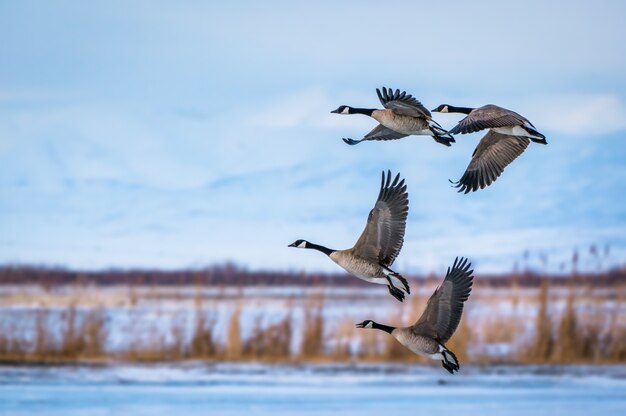Michigan, the Great Lakes State, is known for its stunning landscapes, freshwater bodies, and diverse birdlife. The state offers a rich avian diversity, with various large birds gracing its skies, forests, and wetlands. This article will explore the fascinating world of large birds in Michigan, from majestic bald eagles to the elegant sandhill cranes.
Table of Contents
ToggleTypes of Large Birds in Michigan
- Bald Eagles
Bald eagles are the most iconic large birds in Michigan. With their distinctive white heads and impressive wingspans, they are a sight to behold. These birds of prey are often found near large bodies of water, including the Great Lakes, where they can be seen soaring high in the sky or perched near the shore.
- Sandhill Cranes
Michigan is home to a significant population of sandhill cranes. These elegant birds are known for their long legs and distinctive red crowns. They are often spotted in wetlands and grassy areas, where they forage for food. Seeing a sandhill crane in flight is a memorable experience for birdwatchers.
- Wild Turkeys
Wild turkeys are another large bird species in Michigan. They are known for their impressive size and distinctive fan-shaped tails. Wild turkeys can be found in wooded areas and are known for their unique calls during the breeding season.
Habitats and Distribution
Large birds in Michigan are distributed across a range of habitats. Bald eagles prefer coastal areas, while sandhill cranes thrive in wetlands and grasslands. Wild turkeys are often found in forests and wooded regions. Michigan’s diverse landscape provides a suitable home for these majestic birds.
Migration Patterns
Many large birds in Michigan are migratory. For example, bald eagles often migrate to the state during winter. Understanding these migration patterns is crucial for bird enthusiasts who wish to witness the seasonal movements of these birds.
Behavior and Characteristics
Each species of large bird in Michigan has unique behaviors and characteristics. Bald eagles are known for hunting prowess, while sandhill cranes engage in elaborate courtship dances. Understanding these traits adds depth to the birdwatching experience.
Conservation Efforts
Conservation plays a vital role in preserving the populations of large birds in Michigan. Initiatives and organizations work tirelessly to protect these birds and their habitats, ensuring their survival for future generations.
Birdwatching in Michigan
Popular Birdwatching Locations
Michigan offers numerous birdwatching hotspots. Places like the Pictured Rocks National Lakeshore, Sleeping Bear Dunes National Lakeshore, and the Detroit River International Wildlife Refuge are popular among birdwatchers.
Equipment Needed
To make the most of your birdwatching experience, you’ll need essential equipment such as binoculars, a field guide, and a notebook to record your observations.
The Role of Large Birds in Michigan’s Ecosystem
Large birds in Michigan play crucial roles in the ecosystem. They help control prey populations, contribute to seed dispersal, and serve as indicators of environmental health.
Threats and Challenges
Despite their significance, large birds in Michigan face habitat loss, pollution, and climate change threats. Understanding these challenges is essential for their conservation.
Exciting Facts About Large Birds in Michigan
Michigan’s large birds have many exciting features and behaviors. For instance, did you know that bald eagles can reach speeds of up to 40 miles per hour when hunting?
How to Identify Large Birds
Identifying large birds in Michigan can be a rewarding skill. Learning about their unique physical characteristics and behaviors will enhance your birdwatching experience.
Large Birds and Human Interaction
Large birds have been a part of human culture and history for centuries. They have inspired awe, admiration, and even legends in various cultures.
Legends and Folklore
Michigan’s native peoples have rich folklore and legends associated with large birds. These stories reflect the significance of these birds in the state’s cultural heritage.
Conclusion
Michigan’s large birds are a source of natural beauty and essential to the state’s ecosystem. Their conservation and appreciation are vital in maintaining the ecological balance and preserving the cultural heritage of Michigan.
FAQs (Frequently Asked Questions)
Q1: What is the wingspan of a bald eagle?
A1: The wingspan of a bald eagle can range from 6 to 7.5 feet.
Q2: Are sandhill cranes migratory birds?
A2: Sandhill cranes are migratory birds, often traveling to Michigan for the summer.
Q3: What is the state bird of Michigan?
A3: The state bird of Michigan is the American robin.
Q4: How can I get involved in bird conservation efforts in Michigan?
A4: You can get involved by supporting local conservation organizations, volunteering, and participating in citizen science projects.
Q5: Can I spot wild turkeys in urban areas of Michigan?
A5: While wild turkeys are more commonly found in wooded areas, it’s not uncommon to see them in Michigan’s suburban and even urban neighborhoods.





